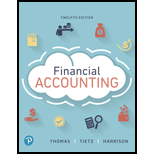
Financial Accounting (12th Edition) (What's New in Accounting)
12th Edition
ISBN: 9780134725987
Author: C. William Thomas, Wendy M. Tietz, Walter T. Harrison Jr.
Publisher: PEARSON
expand_more
expand_more
format_list_bulleted
Question
Chapter 10, Problem 10.99DC
1.
To determine
To Prepare: The analysis to determine the plan that will result in the highest earnings per share of common stock.
2.
To determine
To Recommend: A plan to the board of directors and give the reason for recommending the plan.
Expert Solution & Answer
Want to see the full answer?
Check out a sample textbook solution
Students have asked these similar questions
General accounting question
provide correct answer
Hi expert please give me answer general accounting question
Chapter 10 Solutions
Financial Accounting (12th Edition) (What's New in Accounting)
Ch. 10 - The two main categories of stockholders equity are...Ch. 10 - Prob. 2QCCh. 10 - Stockholders of a corporation directly elect the...Ch. 10 - The par value of a share of common stock a. is...Ch. 10 - Prob. 5QCCh. 10 - If a corporation issues 1,000 shares of 1 par...Ch. 10 - Prob. 7QCCh. 10 - Sandusky Corporation purchased 3,000 shares of its...Ch. 10 - Graves Corporation issued 50,000 shares of 1 par...Ch. 10 - Prob. 10QC
Ch. 10 - For cash dividends, the journal entry on the date...Ch. 10 - Prob. 12QCCh. 10 - Prob. 13QCCh. 10 - Prob. 14QCCh. 10 - Prob. 15QCCh. 10 - Prob. 16QCCh. 10 - Prob. 10.1ECCh. 10 - Prob. 10.1SCh. 10 - (Learning Objective 1: Describe characteristics of...Ch. 10 - Prob. 10.3SCh. 10 - Prob. 10.4SCh. 10 - (Learning Objective 2: Record issuance of stock...Ch. 10 - Prob. 10.6SCh. 10 - Prob. 10.7SCh. 10 - Prob. 10.8SCh. 10 - Prob. 10.9SCh. 10 - Prob. 10.10SCh. 10 - (Learning Objective 4: Divide cash dividends...Ch. 10 - Prob. 10.12SCh. 10 - (Learning Objective 6: Prepare the stockholders...Ch. 10 - (Learning Objective 5: Use stockholders equity...Ch. 10 - (Learning Objective 5: Calculate book value per...Ch. 10 - (Learning Objective 5: Calculate and explain...Ch. 10 - (Learning Objective 5: Calculate return on assets...Ch. 10 - Prob. 10.18SCh. 10 - (Learning Objective 2. 5: Define and use various...Ch. 10 - Prob. 10.20SCh. 10 - Prob. 10.21SCh. 10 - Prob. 10.22SCh. 10 - (Learning Objective 1: Identify key terms...Ch. 10 - (Learning Objectives 2, 6: Account for issuance of...Ch. 10 - Prob. 10.25AECh. 10 - Prob. 10.26AECh. 10 - Prob. 10.27AECh. 10 - (Learning Objective 3: Account for the purchase...Ch. 10 - (Learning Objectives 2, 3, 4: Account for issuance...Ch. 10 - (Learning Objective 6: Report stockholders equity...Ch. 10 - Prob. 10.31AECh. 10 - LO 4 (Learning Objective 4: Calculate dividends on...Ch. 10 - Prob. 10.33AECh. 10 - Prob. 10.34AECh. 10 - LO 5 (Learning Objective 5: Calculate and...Ch. 10 - LO 4,6 (Learning Objective 4, 6: Analyze...Ch. 10 - (Learning Objective 5: Evaluate profitability)...Ch. 10 - Prob. 10.38AECh. 10 - LO 6 (Learning Objective 6: Use a companys...Ch. 10 - (Learning Objective 1: Identify key terms...Ch. 10 - (Learning Objectives 2, 6: Account for issuance of...Ch. 10 - Prob. 10.42BECh. 10 - Prob. 10.43BECh. 10 - (Learning Objectives 3, 6: Show how treasury stock...Ch. 10 - (Learning Objective 3: Account for the purchase...Ch. 10 - (Learning Objectives 2, 3, 4: Account for issuance...Ch. 10 - Prob. 10.47BECh. 10 - Prob. 10.48BECh. 10 - Prob. 10.49BECh. 10 - Prob. 10.50BECh. 10 - (Learning Objectives 2, 3, 4: Measure the effect s...Ch. 10 - Prob. 10.52BECh. 10 - (Learning Objective 5: Analyze alternative plans...Ch. 10 - (Learning Objective 5: Evaluate profitability)...Ch. 10 - Prob. 10.55BECh. 10 - Prob. 10.56BECh. 10 - Prob. 10.57QCh. 10 - Prob. 10.58QCh. 10 - Prob. 10.59QCh. 10 - Prob. 10.60QCh. 10 - Prob. 10.61QCh. 10 - Prob. 10.62QCh. 10 - Prob. 10.63QCh. 10 - Prob. 10.64QCh. 10 - Quill Corporation paid 28 per share to purchase...Ch. 10 - Prob. 10.66QCh. 10 - Prob. 10.67QCh. 10 - Prob. 10.68QCh. 10 - Prob. 10.69QCh. 10 - Prob. 10.70QCh. 10 - Prob. 10.71QCh. 10 - Prob. 10.72QCh. 10 - Prob. 10.73QCh. 10 - Prob. 10.74QCh. 10 - Prob. 10.75QCh. 10 - Prob. 10.76APCh. 10 - (Learning Objective 6: Report stockholders equity)...Ch. 10 - (Learning Objectives 2, 4: Analyze stockholders...Ch. 10 - (Learning Objectives 2, 3, 4: Account for stock...Ch. 10 - Prob. 10.80APCh. 10 - Prob. 10.81APCh. 10 - Prob. 10.82APCh. 10 - Prob. 10.83APCh. 10 - Prob. 10.84BPCh. 10 - Prob. 10.85BPCh. 10 - (Learning Objectives 2, 4: Analyze stockholders...Ch. 10 - (Learning Objectives 2, 3, 4: Account for stock...Ch. 10 - Prob. 10.88BPCh. 10 - Prob. 10.89BPCh. 10 - (Learning Objective 5: Differentiate financing...Ch. 10 - Prob. 10.91BPCh. 10 - Prob. 10.92CEPCh. 10 - Prob. 10.93CEPCh. 10 - Prob. 10.94CEPCh. 10 - Prob. 10.95CEPCh. 10 - (Learning Objectives 2, 3, 4, 6: Analyze...Ch. 10 - (Learning Objectives 2, 3, 4: Calculate impact of...Ch. 10 - Prob. 10.98DCCh. 10 - Prob. 10.99DCCh. 10 - Prob. 10.100EICCh. 10 - Prob. 10.101EICCh. 10 - (Learning Objectives 2, 3, 4, 5: Analyze common...Ch. 10 - (Learning Objectives 2, 3, 4: Analyze treasury...
Knowledge Booster
Similar questions
arrow_back_ios
SEE MORE QUESTIONS
arrow_forward_ios
Recommended textbooks for you
 Intermediate Financial Management (MindTap Course...FinanceISBN:9781337395083Author:Eugene F. Brigham, Phillip R. DavesPublisher:Cengage Learning
Intermediate Financial Management (MindTap Course...FinanceISBN:9781337395083Author:Eugene F. Brigham, Phillip R. DavesPublisher:Cengage Learning



Intermediate Financial Management (MindTap Course...
Finance
ISBN:9781337395083
Author:Eugene F. Brigham, Phillip R. Daves
Publisher:Cengage Learning

